Alice's Adventures in Wonderland
![]()
The title of this article is ambiguous. For other meanings, see Alice in Wonderland (disambiguation).
Alice in Wonderland (originally Alice's Adventures in Wonderland; original English title Alice's Adventures in Wonderland) is a children's book by British author Lewis Carroll, first published in 1865.
Alice in Wonderland is considered one of the outstanding works from the genre of literary nonsense. Together with the sequel Alice Behind the Mirrors, published in 1871, this children's book is counted among the classics of world literature. Today, for example, the story is part of the ZEIT Library of 100 Books. In 2009, the British newspaper The Guardian included both Alice in Wonderland and Alice Behind the Mirrors in its list of the 1000 novels everyone must have read. The narrative style and structure, characters, and metaphor have an unchanged cultural influence. Alice in Wonderland underwent adaptations for the stage and in film. Characters from the tale, such as the Cheshire Cat, the Jabberwocky, the March Hare, and the Mad Hatter, or individual episodes, such as that of the tea party into which Alice falls, have been picked up and quoted again and again in pop culture.
The fictional world in which Alice in Wonderland is set plays with logic in such a way that the tale enjoys great popularity among mathematicians and children alike. It contains numerous satirical allusions - not only to Carroll's personal friends, but also to the school lessons that children in England of the time had to memorize. Most often, the story and its sequel Alice Behind the Mirrors (in the original: Through the Looking-Glass and What Alice Found There) are considered a single entity. The stories are also known for the illustrations by British illustrator John Tenniel in the first editions.
Content
While her sister reads to her from a book, the title character, Alice, sees a talking white rabbit staring at a clock, thinking he is late. Curious, Alice follows him into his burrow. There she falls far down and lands in a room with many doors. After some time, she finds a key with which she can unlock the smallest door. She opens it, but can't make it through because it's too big. Shortly after, she finds a vial with a potion that makes her smaller. But by the time she is small enough, the door is closed again. Because of this, chaos ensues until Alice is finally small enough to enter Wonderland, which is bursting with paradoxes and absurdities.
She goes to the white rabbit's house, eats something there and grows huge. When the white rabbit comes home, he cannot get into the room where Alice is. Alice becomes small again and escapes into the forest. There she meets a caterpillar who helps Alice to get her normal size.
After a short time Alice comes to a duchess, where she meets the Cheshire Cat. She advises her to go to the March Hare and the Mad Hatter, who have been holding a tea party for a long time. However, the tea party is so crazy that Alice decides to leave after a short time.
Eventually she comes to the King and Queen of Hearts; the latter would love to have someone's head chopped off. She asks Alice to play croquet with other animals and people who look like playing cards, with a flamingo being the racket and a hedgehog being the ball. In the end, all but Alice are sentenced to death by the Queen of Hearts, but are pardoned by the King of Hearts so that the Queen of Hearts cannot continue playing.
Shortly after the croquet match, the Queen of Hearts leads Alice to a griffin. The queen orders the gryphon to lead Alice to the turtle-supperich, a hybrid of a calf and a sea turtle, so that he can tell her his life story. While the turtle-supperich is singing a song to Alice and the gryphon, the call goes out in the distance, "The trial begins!" The gryphon escorts Alice back to the Queen of Hearts' castle.
There, a court hearing occurs where the Jack of Hearts is accused of stealing the Queen's cupcakes. In the courtroom, Alice meets the Mad Hatter again, who is supposed to be a witness. Alice is also called as a witness. However, she is now so big that she causes chaos instead of being a witness. Alice wakes up again next to her sister.
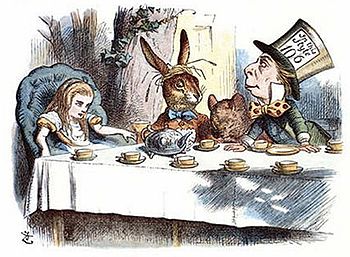
Alice at the tea party by John Tenniel (1865), coloured
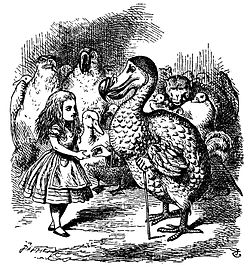
Alice and the Dodo . Drawing by John Tenniel (1865)
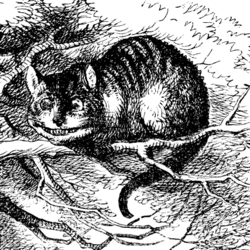
The Cheshire Cat
Works History
The book was first published on 4 July 1865. It was inspired by a boat trip on the Thames exactly three years earlier (the date of this legendary boat trip is commonly given as 4 July 1862, which was, however, a cool, cloudy and rainy day), on which Carroll told a story to the three sisters Lorina Charlotte, Alice Pleasance and Edith Mary Liddell, daughters of the Oxford Dean, which he wrote down first under the name Alice's Adventures Under Ground and then, after extensions, as Alice's Adventures in Wonderland. Carroll was at first undecided whether to publish his work. He gave it in this situation to his friend George MacDonald, who read it to his children. MacDonald's son Greville was so enthusiastic that he wished "there were 60,000 volumes" of it. This enthusiasm was enough to convince Carroll himself. The book was well received as soon as it appeared, and found many enthusiastic readers. These included the young Oscar Wilde and Queen Victoria, among others.
Only twenty-two copies of the 1865 first edition survive today, five of which are in private hands and seventeen in public libraries. In 1998, a first edition sold at auction for $1,500,000, becoming the most expensive children's book to date. In 1865 Carroll published a facsimile of his much shorter, self-illustrated original manuscript Alice's Adventures Under Ground. In 1890, 25 years after the original edition appeared, The Nursery published "Alice," an abridged version of Alice in Wonderland that had been adapted by the author himself for children ages five and under and included twenty colored and enlarged drawings of John Tenniel's illustrations from the original book. The cover was designed by the painter and illustrator Gertrude Thomson, an acquaintance of Carroll.
In 1871 Lewis Carroll published the sequel Through the Looking-Glass, and What Alice Found There (German title: Alice hinter den Spiegeln). Instead of playing cards, the plot in this story is embellished with games of chess.
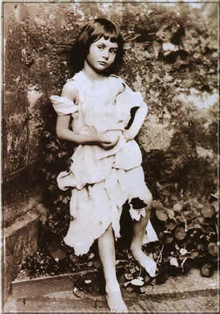
Alice Pleasance Liddell, model for the fictional Alice. Photo by Lewis Carroll from the late 1850s.
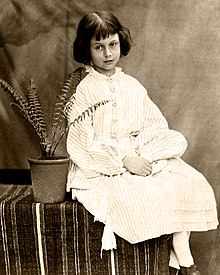
Alice Liddell 1860, 5 years before the first publication.
Search within the encyclopedia

